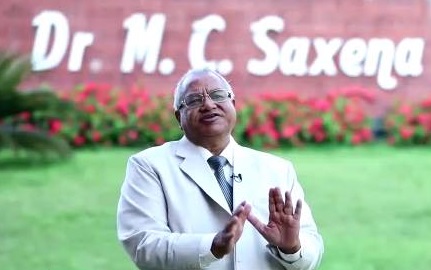Scientific Program
Keynote Session:
Title: Bioinformatics as a vital tool for International peace and national development: The need for its inclusion in United Nation’s charter
Biography:
Mukesh C Saxena is a recipient of several honors & awards and accolade and has chaired several international conferences as a distinguished Scientist, has been a member of Ganga Action Plan Monitoring Committee of the Govt. of India, New Delhi & Coordinator of Aadhar UIDAI drive in Uttar Pradesh, Delhi & U.A for the creation of over 10 million databases.
Abstract:
Nothing can be more concerning than the threat to international peace and the challenges faced by the member nations to address core issues of socio-economic development and coherence to the fabric of societal amalgamation and peaceful co-existence! The creation of a national database of its population via Iris and fingerprint data capturing to provide the national mandate of its member constituents in digital governance vis-a-vis insulation from external and internal threat perceptions from diverse sources has partially succeeded in India- the largest democracy of world!. The much needed economic resources of half of the world are being wasted on the piling of arms, lethal weapons instead of being used for the betterment of basic amenities due to non-adherence of bioinformatics tools in the identification of world population living on planet earth. Each member of planet earth regardless of national boundaries deserves to have its unique identification code of the United Nation besides its affiliation to the country of origin. This would address the core issue of State and nonState players, insulation from a proxy in the field of Education, Food, Agriculture, public distribution system, equity in the horizontal distribution of national and domestic resources etc. The evolution of bioinformatics mechanism to administer, regulate and maintain the national and international harmony and peace is the essence of today’s world! This should be harnessed with scientific precision and dedication to address the global problem of peace for co-existence and right to development.
Title: Structural studies of G protein coupled receptors by using molecular dynamics simulation and docking studies
Biography:
Marlet Martinez has a Ph.D. from Universidad Politecnica de Catalunya, Barcelona and a Postdoc in Structural Bioinformatics from Institut Pasteur, Paris, France. Nowadays, She works at the National Polytechnic Institute (IPN) in Mexico City where she carries out research on Structural Bioinformatics of diverse protein, MD simulations, docking analysis of potential ligands, drug design, among others. She has published about 17 publications in JCR articles, directed about five Master Degree Thesis in Pharmacology and Bioinformatics as well as two Ph.D. theses. She has been invited as a lecturer by the Biophysical Society (USA), Congress of International Drug Discovery.
Abstract:
G protein-coupled receptors (GPCRs) represent one of the largest proteins in mammals that play a key role in the transmission of external signals to the cell interior. GPCRs can be activated by ligands, hormones, light, as many others. GPCRs play a key role in an incredible array of functions in the human body, and increased understanding of these receptors has greatly affected modern medicine. In fact, researchers estimate that about 50% of the entire marketed drugs act binding to GPCRs. As their name implies, GPCRs interact with G proteins in the plasma membrane. When an external signaling molecule binds to a GPCR, it causes a conformational change in the membrane protein. Then, this change triggers the interaction the GPCR and a nearby G protein. Nowadays, computational techniques such as Molecular dynamics (MD) simulations represent a powerful tool to detect these conformational changes that occur in the membrane proteins as a result of ligand binding (1). On the other side, docking analysis permit to predict not only the affinity of the ligands of interest on the membrane proteins but also to identify the residues that are involved in the molecular recognition in the binding process. Our works present some examples of MD simulations of GPCRs by using NAMD Program (2). In this process, we have employed the following force fields, CHARMM22 for protein and CHARMM27 for lipids, and TIP3 model for water molecules. Specific server (OPM) was used to orient the membrane proteins in the lipid bilayer. Structural analysis was carried out by using the Carma Program. From these results, we were able to investigate the stability of the proteins, identification of most flexible residues, and residues which could be involved in the molecular recognition process. Moreover, our results permitted to get some insights about the design of known or new drugs that target these important receptors.
Title: Comparative interactomic analysis to decipher the role of genes involved in rifamycin production in genetically modified Amycolatopsis mediterranei S699
Biography:
Gauri Garg Dhingra is currently working as Assistant Professor Zoology since 2006 at Kirori Mal College, University of Delhi, India. She completed her PhD on the topic “Manipulations of Rifamycin Gene Cluster in A. mediterranei and its partial characterization in A. rifamycinica and Post-Doctorate on “Comparative Genomics” under the supervision of Prof. Rup Lal, Department of Zoology, and University of Delhi, India.
Abstract:
The development of rifampicin-resistance strains of Mycobacterium tuberculosis (Mtb) has resulted in imperative need for development of analogs of rifamycin. The endless efforts by genetic manipulation of rifamycin biosynthetic gene cluster of Amycolatopsis mediterranei S699 has led to discovery of a new anti-tuberculosis drug, 24-desmethylrifamycin B, more effective against rifampicin-resistance strains of Mtb. The mutant strain A. mediterranei DCO#34 had undergone substitution of acyltransferase domain of module 6 of rifamycin polyketide synthase with that of module 2 of rapamycin polyketide synthase. Genetic manipulation resulted in reduced yield of analog ~20mg/litre as compared to 50mg/l yield by the wild type strain. In order to decipher the impact of domain swapping on rifamycin/analog production, and the intricate make-up and clinical importance of rifamycin brought up the idea to study the regulation of rifamycin biosynthesis, state-of-the-art protein expression methodologies were carried out. Whole cell proteins were extracted and digested with trypsin. The resulting peptides were analysed by nLC-MS/MS (Thermo Scientific Q Exactive HF Mass Spectrometer in conjunction with Dionex Ultimate 3000 UPLC). The emerging technique of protein-protein interaction approach was employed to determine the relation and interaction between various structural and regulatory genes involved in Rifamycin biosynthetic gene cluster. Comparing the relative abundance expression values for the wild type and mutant strain revealed the altered expression of structural genes, rifC-I (down-regulated), rifR, rifZ and other regulatory genes (up-regulated), that might have resulted from modified rifamycin polyketide backbone by domain swapping. Reduced yield of analog by the mutant strain is the outcome of subsequent down-regulation of structural genes due to absence of rifP transport gene. The repressed rifamycin transportation outside the cell further activated negative feedback mechanism. Complete protein profile of the rifamycin B producer A. mediterranei S699 revealed intricate mechanisms of rifamycin biosynthesis and its regulation.
Title: Potential leads in Tuberculosis management using bioinformatics tools
Biography:
Dr. Namarta Agarwal has completed her MBBS at the age of 27 years from Kathmandu University, Nepal. She is director of Pharmacy in Dr. M C Saxena Group of Colleges.
Abstract:
4-hydroxy-tetrahydrodipicolinate synthase (DHDPS) is an important enzyme needed for the biosynthesis of lysine and many more key metabolites in Mycobacterium tuberculosis (Mtb). Inhibition of DHDPS is supposed to a promising therapeutic target due to its specific role in sporulation, cross-linking of the peptidoglycan polymers and biosynthesis of amino acids. In this work, a known inhibitor-based similarity search was carried out against a natural products database (Super Natural II) towards the identification of more potent phyto-inhibitors. Molecular interaction studies were accomplished using three different tools to understand and establish the participation of active site residues as the key players in stabilizing the binding mode of ligands and the target protein. The best phyto-compound deduced on the basis of binding affinity was further used as a template to make similarity scan across the PubChem Compound database (score > = 80 %) to get more diverse leads. In this search, 5098 hits were obtained that further reduced to 262 after drug-likeness filtration. These phytochemicals like compounds were docked at the active site of DHDPS. Then, those hits selected from docking analysis that showing stronger binding and forming maximum H-bonds with the active site residues (Thr54, Thr55, Tyr143, Arg148, and Lys171). Finally, we predicted one phytochemical compound (SN00003544), two PubChem-compounds (CID41032023, CID54025334) akin to phytochemical molecule showing better interactions in comparison of known inhibitors of the target protein. These findings might be further useful to gain structural insight into the designing of novel leads against DapA family.
Oral Session 1:
- Bioinformatics and Computational Biology| Drug Design and Developnment | Molecular Modeling | Structural & Evolutionary Bioinformatics | Emerging Trends in Proteomic
Title: Structural insights of HDAC6 deacetylase catalytic domains
Biography:
Yudibeth Sixto-Lopez is a Ph.D. student from Escuela Superior de Medicina of the Instituto Politecnico Nacional, Mexico where she also did her Master. She performed an academic stay at University of Granada, Spain. She has published 6 papers in reputed journals.
Abstract:
Histone Deacetylase 6, belong to class II HDAC family with unique structural characteristics since it possesses two deacetylase catalytic domains (DD1 and DD2), which are interconnected by a linker region. HDAC6 deacetylate non-histone substrate such as cortactin, α-tubulin, P53, tau protein, among others. The malfunction or deregulation of this protein has been involved in several diseases including cancer, Alzheimer´s diseases, and Parkinson´s diseases. Thus, it has emerged as a pharmacological target for the treatment of these diseases. In order to design new drugs to target HDAC6 selectively, it is important to have structural knowledge of this enzyme. Thus, in the present study, we built a three-dimensional (3D) model of DD1 and DD2 bound by the linker region, in order to identify the interactions established selectively by HDAC6 inhibitors and elucidate the participation of both catalytic domains in the recognition we used molecular docking and molecular dynamic simulation tools. As results, we found that the catalytic tunnel of DD1 is wider and shallower than DD2 with different residue composition that could be exploited to achieve ligand selectivity design. By MD simulation and docking it was possible to determine the residues that contribute favorably to the ligand-HDAC6 recognition, in DD1 the residues were F105, S173, H215, G224, Y225, H255, W284, K353, and R383 and in DD2 were: H500, P501, S568, P608, H610, H611, H619, F620, H651, F680, P748, L749, E779, E780 and Y782. Finally, MD simulation reveals some structural difference in the terminal loops, a linker region, and loops adjacent to the catalytic site between the apo-HDAC6 model and the ligand-HDAC6.
Title: In silico identified immunogenic Ebola nucleoprotein peptides elicit immune response
Biography:
Sahil Jain has completed his BTech at the age of 23 years from Jaypee University and joined Thapar Institute of Engineering and Technology (TIET) as a Ph.D. student in 2015. He worked for more than 3 years in information technology and pharmaceutical sectors and is currently employed as a teaching assistant at TIET since 2016.
Abstract:
Immunoinformatics has come by leaps and bounds to finding potent vaccine candidates against various pathogens. In the current study, a combination of different T (CD4+ and CD8+) and B cell epitope prediction tools were applied to find peptides containing multiple epitopes against Ebola nucleoprotein (NP) and the presentation of peptides to human leukocyte antigen (HLA) molecules was analyzed by prediction, docking, and population coverage tools. Further, ELISA was carried out to measure IFN-γ in peptide-stimulated peripheral blood mononuclear cells isolated from the blood of healthy volunteers. Six peptides containing multiple T and B cell epitopes were obtained after prediction studies and eliminating the peptides liable to generate an autoimmune and allergic response. All peptides displayed 100% conservancy in Zaire Ebola virus. Prediction tools, Auto dock Vina and CABS-dock results confirmed the ability of predicted peptides to bind with diverse HLA alleles. Population coverage analysis predicted high coverage (> 85%) for the expected immune response in four continents (Africa, America, Asia and Europe). Peptide-stimulated cells showed enhanced IFN-γ secretion as compared to unstimulated cells. Therefore, the identified NP peptides can be considered as potential synthetic vaccine candidates against the Ebola virus.
Title: Comparative analysis of CpG islands in Dengue virus for methylation induced gene silencing as an epigenetic tool
Biography:
Mansi Verma is the Assistant Professor at Sri Venkateswara College, Delhi University, India. She received her Bachelor’s and Master’s degree in Zoology and completed a Ph.D. in Molecular Biology in 2011 from University of Delhi. She was recently awarded as Young Scientist by Association of Microbiologists of India (AMI) and has contributed 23 research articles in journals of International reputation. She has also published 2 chapters of international reputation, 8 e-chapters, and 1 book chapter. She has participated in more than 15 Conferences/ workshops and presented more than 28 posters. She has successfully completed 3 projects as Principal Investigator. She was also awarded a Certificate of Appreciation for presenting research work as a poster presentation at the 94th Foundation Day of University of Delhi at Viceregal Lodge on May 1, 2016.
Abstract:
DNA methylation plays a crucial role in the regulation of gene expression, including the expression of viral genes. Viral genome uses host machinery to replicate and therefore, methylation at CpG islands of viral DNA can help in regulating the replication of the dreadful pathogens. In the present study, comparative genomics was performed for Dengue virus which a life-threatening virus is causing millions of deaths every year. So far, very little is known about the effects of mutations in DENV serotypes. This study included more than 3000 genome sequences of four serotypes of Dengue virus. These sequences were evaluated and interpreted. On analysis of complete sequences of DENV serotype 1, three CpG islands were found. Likewise, for DENV-2, DENV-3, and DENV-4; two, four and three CpG islands were found, respectively. On comparing CpG sequences of DENV serotype 1 and DENV serotype 2, no major identity pattern was recorded as such. But, on blasting CpG sequences of serotype 1 and serotype 3, >90% query coverage and >90% identity on average was recorded. In case of CpG blast of serotype 1 and serotype 4, although the query coverage was low (<50% on average), the identity was high (>90% on average) and in many cases was completely identical i.e. 100%. The results exhibited that the site of DNA methylation is preserved in DENV-1, 3 and 4 even after having evident disparities among all serotypes. This can be exploited for methylation-induced gene silencing for aiming a mutual vaccine or drug. In the field of comparative genomics, our study can direct to a novel perceptiveness of epigenetics.
Title: Structural importance of the additional metal binding site in HDAC1
Biography:
Yudibeth Sixto-Lopez is a Ph.D. student from Escuela Superior de Medicina of the Instituto Politecnico Nacional, Mexico where she also did her Master. She performed an academic stay at University of Granada, Spain. She has published 6 papers in reputed journals.
Abstract:
Histone deacetylases (HDACs) are a family of proteins whose main function is the removal of acetyl groups from lysine residues located on histone and non-histone substrates, which regulates gene transcription and other activities in cells. HDACs are composed of 18 isoforms grouped into four classes, three classes are zinc-dependent, class I (HDAC1, 2, 3 and 8), II (HDAC4, 5, 6, 7, 9 and 1) and IV (HDAC11); and the other is NAD+-dependent (class III), so-called “sirtuins”1. HDAC1 has been involved in cancer development, thus its inhibition has emerged as a promissory therapeutic strategy, and the acquisition of the structural knowledge could help in the rational drug design in order to achieve selective inhibitors2. HDAC1, possess two additional conserved metal binding sites (Site 1 and Site 2), also described in other isoforms, suggesting a possible structural role that affects HDAC catalytical activity. In this work, we performed molecular dynamics (MD) simulation of HDAC1 in order to reveal structural details about these sites and how it affects the interactions with reported HDAC inhibitors. Our results suggest that these sites play an important structural role, since it impacts in the structural flexibility of HDCA1 reflected in parameters like RMSD and RMSF, it also affects the molecular recognition between the inhibitor and HDAC1.
Title: Recommendations of somatic variants detection with Next-generation sequencing (NGS) data
Biography:
Xiaoyu He is pursuing Ph.D. and her research interests include high-performance computing and bioinformatics.
Abstract:
The high-throughput and increasingly affordable nature of Next-Generation Sequencing (NGS) has greatly improved our ability to detect genomic variants. Although reliable results and rapid processing are critical in biomedical research and clinical applications, the accuracy of variants detection is the core concern of researchers. Characteristics of data are the decisive factor in algorithm and parameter selection, however currently popular and widely used pipelines often lack detailed parameters, such as GATK best practices, Genome VIP and integration software may SpeedSeq, which will mislead inexperienced analyst. In addition, quality management throughout the pipeline is severely overlooked, and quality control is often only found during the raw sequencing data. Therefore, a detailed and comprehensive analysis pipeline and quality management in each step are of significant importance. In this study, we discussed and summarized how to make a choice on software and parameters depending on the data characteristics. We also clarify the current quality management strategies for Illumina technology-based sequencing data at different stages of analysis based on an idea of the gain pattern of information. Which means new information is emerging and new detail and delicate metrics should be defined to ensure accurate results as the analysis goes on.
Title: Emerging trends and advances in methodologies and techniques in proteomics
Biography:
Abhishikt David Solomon is an undergraduate student of BTech in Biotechnology who is studying in the 3rd year of his course of study at Sam Higginbottom University of Agriculture, Technology and Sciences (SHUATS), Allahabad (Formerly Allahabad Agriculture Institute). He has had a good experience in the field of plant tissue culture and various laboratory practices and techniques during his training at recognized institutions such as ICAR-IISR (Indian Council of Agricultural Research- Indian Institute of Sugarcane Research) and CSIR-CIMAP (Council of Scientific and Industrial Research-Central Institute of Medicinal and Aromatic Plants).
Abstract:
Along with the emergence of the biotechnology practices in the research and development sector within the past decade, proteomics has played a major role in determination of the behavior of protein and its analysis in the organism’s genetic makeup and expression in several species of organisms which helped the researchers and biotechnologists to identify and quantify the protein based on their amino acid sequences. It also helped to understand post-translational modifications, alterations and deletions in proteins through various in vivo techniques such as real-time imaging systems, vascular proteomic mapping and various tools of system biology and bioinformatics. These techniques lead to the advancement in the current scenario of proteomics and also help to extrapolate the discoveries and researches like the characterization of human plasma proteome, protein identification leading to mosquito birth control, and pancreatic cancer research. This article retrospects and introspects upon the methodologies and the techniques used to predict the protein structure in order to bring about the advances in the proteomics research and bioinformatics such as in the field of medicinal biotechnology, drug design (CADD), homology modeling, ab initio structure prediction, nano-LC, etc.
Title: Computational screening of potent anti-dengue inhibitors against Dengue NS2B/NS3 protease
Biography:
Ruilin Li is a Ph.D. candidate and her research interests include high-performance computing and bioinformatics.
Abstract:
Gene prediction is an important approach to improve the annotation of metagenomic genes. A variety of gene prediction models based on different principles had been implemented, with emphasis on statistical models, Markov or improved Markov models, deep learning models, and so on. The current gene prediction algorithms, such as FragGeneScan, Prodigal, MetaGeneAnnotator, Orphelia, Glimmer3, GeneMarkS-2, were specially designed for short fragments or whole genomes; however, the former will result in the identified genes being incomplete and the latter is not suitable for unknown species. Meanwhile, according to our previous benchmark results of these algorithms, the prediction error rate was relatively high (27.10%~54.70%), especially for datasets with low coverage (staggered dataset). In this study, we proposed an algorithm based on feature selection of ORFs named as Consensus, which combined the ORFs generated from known models, extracted the ORFs’ feature matrix and the corresponding label matrix. Finally, the optimal solution was obtained by the least square’s solution to the feature and label matrixes. The overall indicator of gene prediction via Consensus was better than that of single software (F-score was 82.94% on the staggered dataset). Even more remarkably, we compared the results of models using two longer assembled scaffolds datasets of the real mock metagenomic samples containing 20 bacterial strains from NCBI (National Center for Biotechnology Information) instead of simulated reads, which would truly reflect the predictive power of the models. We believe our findings will improve the study of novel genes and annotation pipelines in unknown metagenomic species.
Keynote Session:
Title: Prospective application of bioinformatics in the treatment of Alzheimer’s disease
Biography:
Dr. Namrata Agarwal has completed her MBBS at the age of 27 years from Kathmandu University, Nepal. She is director of Pharmacy in Dr. M.C Saxena group of colleges.
Abstract:
Alzheimer's disease is a progressive neurodegenerative neurologic disease that results in the irreversible loss of neurons, particularly in the cortex and hippocampus. The disease is characterized by low levels in the brain of the neurotransmitters acetylcholine (ACh) and dopamine (DA), respectively. The acetylcholine is mainly inhibited by the acetylcholinesterase which is a hydrolase that hydrolyzes choline esters. Major advances in the treatment of AD have been the use of acetylcholinesterase inhibitors such as Sulmepride, Promazine hydrochloride to increase the levels of ACh rather than the use of cholinergic compounds. In this first approach, it was found that approved drug against the acetylcholinesterase was 1516, in the approved drug library and out of these 17 were found to have a similar structure (using Swiss similarity ) like promazine hydrochloride. Then we applied ADMET and as a result, we got 10 compounds which fulfilled the ADMET criteria, then these 10 compounds were subjected to Lipinski rule of five (RO5) and out of these best two compounds were found having the ID DB00548, DB00770 ( azelaic acid & alprostadil respectively). Further molecular docking of these two compounds will be carried out using autodock4.0
Title: Conserved epitopes of DENV structural and non-structural proteins for exploring universal vaccine targets
Biography:
Mansi Verma is an Assistant Professor at Sri Venkateswara College, Delhi University, India. She received her Bachelor’s and Master’s degree in Zoology and completed a Ph.D. in Molecular Biology in 2011 from University of Delhi. She was recently awarded as Young Scientist by Association of Microbiologists of India (AMI) and has contributed 23 research articles in journals of International reputation. She has also published 2 chapters of international reputation, 8 e-chapters, and 1 book chapter. She has participated in more than 15 Conferences/ workshops and presented more than 28 posters. She has successfully completed 3 projects as Principal Investigator. She was also awarded a Certificate of Appreciation for presenting research work as a poster presentation at the 94th Foundation Day of University of Delhi at Viceregal Lodge on May 1, 2016.
Abstract:
Dengue is a severe emerging arthropod-borne viral disease occurring globally. Around two-fifths of the world’s population or up to 3.9 billion people are at risk of dengue infection. Infection induces a life-long protective immunity to the homologous serotype but confers only partial and transient protection against subsequent infection against other serotypes. Thus, there is a need for a vaccine which is capable of providing lifelong protection against all the serotypes of the dengue virus. In our study, comparative genomics of Dengue virus (DENV) was conducted to explore potential candidates for novel vaccine targets. From our analysis we successfully found 100% conserved epitopes in Envelope protein (RCPTQGE); NS3 (SAAQRRGR, PGTSGSPI); NS4A (QRTPQDNQL); NS4B (LQAKATREAQKRA) and NS5 proteins (QRGSGQV) in all DENV serotypes. Some serotype specific conserved motifs were also found in NS1, NS5, Capsid, PrM and Envelope proteins. Using comparative genomics and immune informatics approach, we could find conserved epitopes which can be explored as peptide vaccine candidates to combat dengue worldwide. Serotype-specific epitopes can also be exploited for rapid diagnostics. All ten proteins are explored to find the conserved epitopes in DENV serotypes, thus making it the most extensively studied viral genome so far.








